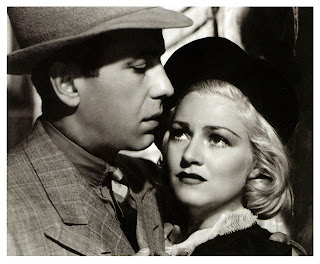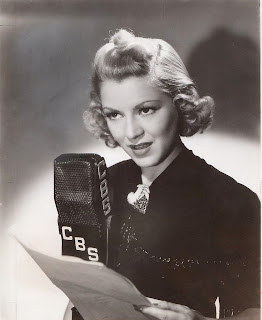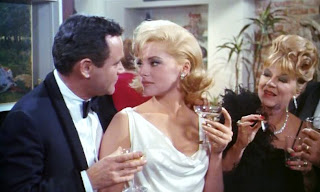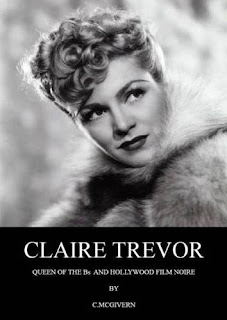
Most “tough babes” in movies came to be seen as camp figures, even jokes, but that was never the perception with Claire. Claire Trevor never became a joke. Audiences and critics alike always regarded her with respect. But quiet respect rarely assures top stardom. Though often starred, she never became a true box office star. Her feelings about her career constantly veered back and forth from diffidence to despair, ambition to acceptance, envy to ennui. She utterly lacked the iron-willed determination of a Barbara Stanwyck or the temperament of a Joan Crawford. Perhaps that was a blessing. Her career saw a dazzling number of setbacks, disappointments and re-discoveries, but she continued to be active long after more illustrious contemporaries outlived their vogues.

She was born Claire Wemlinger in the Bensonhurst section of Brooklyn on March 9, 1910, the only child of Noel B. and Edith Morrison Wemlinger. (Her father was born in Paris, her mother in Belfast.) The family moved to New York City when Claire was two and there she attended George Washington High School. Mr. Wemlinger, a successful Fifth Avenue custom tailor, moved the family then to nearby Larchmont. Claire attended Mamaroneck High School, where she got her first taste of performing. It was originally intended that upon graduation she attend Smith College but she enrolled instead at Columbia University where she studied art, but she had to quit after only six months because the Depression had cost her father his business and Claire had to help out financially. Having appeared in plays in school, she’d become smitten with acting and entered the American Academy of Dramatic Arts, but after six months she left to try and obtain some paying jobs and launched her attack on the big-time Broadway boys.

She often made the rounds with her long-time friend Martha Sleeper, who was already an experienced actress. For a while she called herself Claire Sinclair, having been impressed with a Sinclair Oil sign, changed that to Claire St. Clair, but soon dropped both in favor of Trevor. Armed with youth, beauty and a list of credits as impressive as it was phony, she managed to land her first acting job. She spent the summer of ’31 as the leading ingenue with the Hampton Players, a little theater group in Southhampton, New York, for $5 a week plus room and board. While there she was spotted by producer Alexander McKaig, who offered Claire her first Broadway role, leading lady in Whistling in the Dark opposite Ernest Truex and Edward Arnold. In his review for the Herald-Tribune, Percy Hammond wrote: “Claire Trevor, a shiny debutante, plays the pretty heroine casually.”

While the company was in Los Angeles, a number of film studio executives offered her screen tests. “Irving Thalberg had wanted me to sign at MGM,” Claire later said, “But at the time I was all theater-conscious. I told him that I would wait until some studio brought me to Hollywood from a hit play and give me a starring role in a picture. I’ve often wondered if I was foolish not to sign with Mr. Thalberg then. My career might have been much more successful.” She went back to New York and got a part as a waitress in a Depression comedy called The Party’s Over, which opened at the Vanderbilt Theatre on March 27, 1933. The critics were casually kind but the play was not doing very well, so when the New York office of Fox Films (renamed 20th Century-Fox in 1935) tested her and offered her a contract she readily accepted. She left the show at the end of April and arrived in Hollywood on May 7, 1933, a contract player with a major studio at $350 a week, a fortune to her. Two days later Claire was sent out on location, a sandy waste, for her first movie, Life in the Raw, a run-of-the-mill Western in which she was George O’Brien’s leading lady.

Fox decided to bring her indoors to play opposite Spencer Tracy in The Mad Game, a newspaper drama. She got excellent notices for her work as a cigarette-rolling reporter. By the end of 1933 she had starred in half-a-dozen Fox quickies. Early in ’34 her personal rave notices began piling up, but in minor films earning little or no attention. The pattern was set; Claire Trevor became Hollywood’s (or at least Fox’s) Queen of the B’s. She said in the April, 1934 Picture Play: “The studios usually artificialize women. I vowed I wouldn’t be beautified, but it’s a routine you have to go through every morning out here…. Pictures seem to me like the stock market, a magnificent gamble. My wish is that I’ll go to the top and then have sense enough to get out before I crash.”

Claire Trevor had become a known name and she was learning, absorbing, becoming thoroughly accustomed to delivering high-level performances under all but impossible conditions. As her income grew, so did her impatience for bigger and certainly better things. Later, in a 1946 Motion Picture interview, she said, “Producers decided I was older than I claimed to be and gave me snappy, severe business women, gal reporter types of roles. I played them all. I didn’t know that to make a real career in Hollywood you have to become a ‘personality.’ You have to cultivate publicity departments and become known as ‘The Ear’ or ‘The Toe.’”

Her patience and persistence finally seemed to pay off. She fought for, and won, the part of Francey in Dead End, a major production for United Artists, released in 1937. She had only one scene, as gangster Humphrey Bogart’s innocent one-time girlfriend who had turned into a hardened, diseased prostitute. (Claire and Bogart became fast friends for life.) No one could understand why on earth she wanted to play such a part, until they saw the film. Her contribution lasted less than two minutes, but she made every second count. The press and public finally took notice and she was nominated for a a 1937 Best Supporting Actress Academy Award. She didn’t win, Alice Brady did for In Old Chicago, but Claire felt this was a definite step up.

Free of her Fox contract in 1937, she gave an unusually candid interview in the June 1938 Modern Screen: “At first I accepted anything I was handed. When the scripts turned out to be crummy and inconsistent I just did the best I could. I thought Dead End was going to mean everything —a beautiful script, good director [William Wyler], topflight cast— but I was disappointed in my performance when I saw the picture. I hadn’t given what I thought I had… But they’ve kept me buzzing in the B-hive for four years and no relief in sight.

So one of these days I’m going to surprise everybody and say, ‘No, this part is not for me, this picture is not for me, I won’t do another B!’” “Perhaps I’ve been amiable too long,” she said in the May, 1938 Motion Picture. “Perhaps it’s time for me to put on the temperamental act and scream for better parts in better pictures. Next year I hope some really good roles in important productions will come my way. Naturally I would prefer to make three or four pictures a year which are important, rather than twice that number of the run-of-the-mill variety.” The title of the interview said it all: The Star Who Isn’t a Star.

She married Big Town producer Clark Andrews in July 1938. By then the last of her Fox follies were in release, and she was seen in two top-line Warner Bros. efforts: The Amazing Dr. Clitterhouse, an excellent gangster comedy with Claire playing a gang leader with silken ease, and Valley of the Giants, her first Technicolor picture and the first of many films to exploit her as a lady with a past in Western surroundings.

She was offered a Warners contract but, still smarting from her bondage at Fox, she refused. She told William M. Drew in his 1999 book At the Center of the Frame, “Warner Bros. had a promotional thing going at the time and they wanted me to be ‘the Oomph Girl.’ They wanted to sign me for five years but I turned them down… That may have been foolish too, because I would have been ‘the Oomph Girl’ rather than Ann Sheridan and also Warners did more of the kind of thing that was suitable to me.”

Texas (1941) was a funny, bouncy western, this time with buddies Glenn Ford and William Holden vying for Claire’s favors. In The Adventures of Martin Eden (’41) Claire was star Ford’s colorless true love. Honky Tonk (194l) was an MGM Clark Gable-Lana Turner vehicle typical of her luck. Trevor was featured as Gable’s old flame, an easy going saloon hustler. She started out with a good, gutsy part, but, as she told writer Charles Samuels eight years later, “By that time I was playing second leads. I had great scenes in Honky Tonk. At least I thought I had them ’til I went to the press preview of the picture. My scenes had been scissored out. ‘Where am I?,’ I kept asking myself. ‘What happened to me?’ I cried all the way home and swore I’d never make another picture. There were a lot of nights when I felt like that. Other girls were flying past me becoming big stars. I was still just another actress, competent but not a top-notcher. Still, I didn’t care too much.” She married Navy Lt. Cylos William Dunsmoore in 1944, and the following year their son, Charles Cylos, was born.

Claire co-starred on radio in 1944 with her old Fox cohort Lloyd Nolan in Results, Incorporated. It was a light-hearted (and headed) mystery series on Mutual, lasting from October 7th to December 30th. She loved radio—no lines to learn, no hours wasted on wardrobe, makeup and hairdos—and appeared in dozens of dramas and variety shows.

After the birth of her son, Claire was a hyper-glam temptress with greed in her eyes and a gun in her upsweep in Murder, My Sweet (1945). It was a classic film noir mystery which did wonders for former boy crooner Dick Powell in his first hard-guy role as detective Philip Marlowe, and consequently all the attention was focused on his surprisingly gritty performance. Claire had a good bit of grit herself. “You shouldn’t kiss a girl when you’re wearing that gun,” she tells Powell. “It leaves a bruise.” Powell got the girl (Anne Shirley) and the publicity. Trevor got a bullet.

In 1947 she played one of the bitchiest of her screen witches, a totally amoral schemer who teams up with killer Lawrence Tierney in Born to Kill. Now considered a noir classic, it was then passed by as just another RKO melodrama. She was the very spirit of evil as she hatched one sleazy scheme after another with not a trace of conscience while wearing some of the funniest ’40s millenary ever constructed. As always, the high quality of her work was overlooked. By now this was exactly what people expected of Claire Trevor, and exactly the genre in which they expected to find her.

Rosalind Russell offered her a supporting role in The Velvet Touch, the first of five films she turned out in breakneck procession. All were released within a few months of each other and suddenly Claire Trevor was the surprise re-discovery of 1948.

That year she discussed her career ambivalence: “Certainly I’d like to be a star,” she told Jack Holland, “because the opportunity for a variety of roles is so very good. I didn’t feel that way once. I thought only of all the worries the stars had; the lack of privacy, the grief and strain of worrying if each succeeding picture would be a failure. But when I see the excellent roles that Barbara Stanwyck, Irene Dunne, Olivia de Havilland, Joan Fontaine, Ingrid Bergman and others have had, I find myself wanting the same chance…. At the beginning I accepted every part that was handed to me. I was too meek. I never acted as though I was eating my heart out for a certain part.

But 1948 turned out to be a very good year for Claire Trevor. It was John Huston’s Key Largo that cinched her umpteenth comeback, this time for keeps. It was a high-profile, star-filled drama (Bogart, Bacall, Robinson, Lionel Barrymore, all close friends), but Claire’s performance as a gangster’s broken-down floozie was so powerful she walked off not only with all the notices but an Oscar for Best Supporting Actress of 1948. She played Gaye Dawn, a former singer who was now Robinson’s alcoholic mistress. In the film’s best remembered sequence, Robinson forced her to sing her long-ago hit song, “Moanin’ Low,” before giving her the drink she’d been begging for, and then refused when she finished because “You were rotten.” It was a wrenching scene and one of her most impressive screen achievements.

She and Dunsmoore had divorced in 1947 and on November 14, 1948, she was married to producer Milton Bren. This one was for keeps. Bren had two teenaged sons, Peter and Donald, from a previous marriage, and Claire helped raise them along with her son Charles. “I didn’t begin my life until I married Milton Bren,” she said in 1999.

Claire starred with Fred MacMurray in Borderline, produced by husband Milton Bren and again showing her gift for comedy. It was a brisk, well-played adventure, though no world-beater. For the next three years she appeared in widely assorted roles, always to fine critical notice. The films may not have been top box -office, but her Oscar had extended her screen career and gave her professional reputation a permanent face lift. Her performances remained exceptional and her merit was fully and repeatedly acknowledged.

Speaking to Louis Reid in 1950 about her bad girl image, Claire said: “If I had my choice, I’d rather be a bad girl in a good picture than a good girl in a bad one. I don’t care how I look—brazen, blowzy, brassy—if the role is of the bad ‘un, it’s all to the good. I’ve been all kinds of menaces—young, middle-aged, intermediate-aged, modern, old-fashioned—in big city underworlds and frontier towns. Sometimes I’ve had a heart of gold but more often my heart is only tarnished gilt. The idea is to look tough, live hard, be dangerous… I never knew any women as bad as those I’ve played on the screen. Never have I had the slightest acquaintance with a female dipso such as I depicted in Key Largo.”

Between 1951 and ’53 she did a variety of starring and supporting roles in mostly programmers: Best of the lot was Hard, Fast and Beautiful, directed by Ida Lupino. Claire was the calculating, overly ambitious mother of tennis champ Sally Forrest, and she imbued the role with a stunning harsh reality.

She did a small part opposite Spencer Tracy in The Mountain (1956). It starred Tracy and Robert Wagner as exceedingly unlikely mountain-climbing brothers, with Tracy turning to Trevor for some brief affections. She won particularly impressive critical response for her incisive turn in Marjorie Morningstar (1958) as Marjorie’s shrewd Jewish mother, one of her finest performances.

In 1964 she was Eddie Mayehoff’s wisecracking take-charge wife in How to Murder Your Wife, a middling Jack Lemmon comedy, and in ’67 she was in the little-seen The Capetown Affair, made in South Africa. This was a remake of 1953’s Pickup on South Street, with Claire in the Thelma Ritter role as a weary, doomed bag-lady. She wasn’t seen on the big screen again for 15 years.

In 1968 Claire again took to the boards in a pair of regional tours. She starred with Rock Hudson and Leif Erickson in Charles Laughton’s adaptation of John Brown’s Body and startled everyone by playing the fierce, cigar-smoking title lesbian in The Killing of Sister George. For the next ten years she devoted herself to painting, charitable causes and enjoying the good life in happy unofficial retirement. Then, in 1978, Claire’s son Charles, 34, was killed in an airplane collision over San Diego, and a year later Milton Bren, her husband of 31 years, died of a brain tumor. Claire was devastated by these twin tragedies within one year. She later told the Los Angeles Times that Bren’s death “was the biggest loss except for our son, who was killed. That was something you never get over. But losing my husband left me without anybody. I mean, I felt completely alone.”

Anthony Quinn with Claire Trevor in 1984
By the 90s she had moved back home to Newport Beach and was keeping a low public profile. In 1999 she met the Dean of the University of California, Irvine, School of the Arts, who invited her to come by and visit their theater. Claire took an interest in the program and began doing some off-the-cuff, informal master classes for the students. Along with additional bequests from the Bren family, the amount totaled $10 million. In her honor it has been renamed the Claire Trevor School of the Arts. At the formal dedication, her stepson Donald Bren said, "Claire last appeared publicly on this very stage, on a blustery day in January almost three years ago."

That’s when a wonderful group of students brought tears to Claire’s eyes with their performance and then she came up on stage and answered their questions about her many years of acting opposite such stars as John Wayne, Humphrey Bogart, Clark Gable and Spencer Tracy. She stole the show and she stole their hearts. Then she opened her heart and gave a [$500,000] gift to the theater, and I’m thrilled to be able to help students achieve their goals.” He then added, “Claire was a remarkable person in every way.” Bren concluded his speech by presenting the school with Claire’s Oscar and her Emmy. Now that’s giving back. -"Claire Trevor - Brass with Class" from "Killer Tomatoes: Fifteen Tough Film Dames" (2004) by Ray Hagen and Laura Wagner

Claire Trevor was unparalleled throughout a Hollywood acting career that spanned seven decades. She found reward and critical acclaim hard to come by despite being unexpectedly Oscar nominated as Best Supporting Actress for just a few seconds of powerful dialogue in the movie Dead End (1937), and although she eventually won an Oscar for her portrayal of a down and out gangsters moll in Key Largo (1948), she never really made it to the stratospheric heights of stardom that others took for granted. Despite her magnificently sensitive portrayal of Dallas opposite John Wayne in Ford's Stagecoach (1939), a cursory glance in her direction might suggest she was subsequently type-cast in Poverty Row Westerns even as she later transformed into the bad-girl of Film Noire.

Here, McGivern investigates Trevors many screen representations in detail, often focussing on contemporary dominant historically specific concepts of American society and culture that gave rise to the Western and Film Noire. She delves deep into the life and image of Claire Trevor, looking at how her starring roles often seemed to reflect the tensions, paradoxes and contradictions of a bleak and uncertain future for many Americans who existed in a period of unprecedented national power and prosperity. This new biography "Claire Trevor: Queen of the Bs & Hollywood Film Noire" by Carolyn McGivern will be released on 1st June 2013.



















.jpg)








































